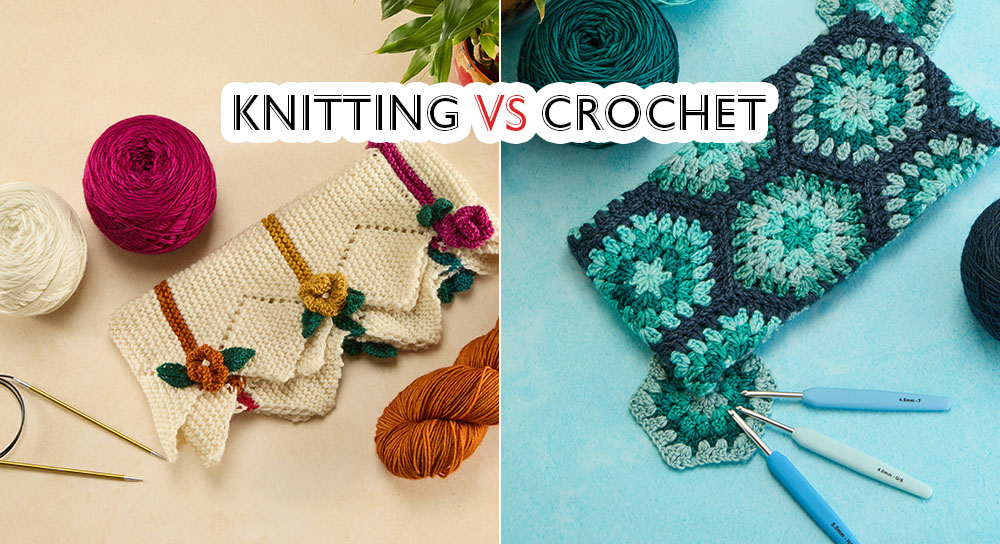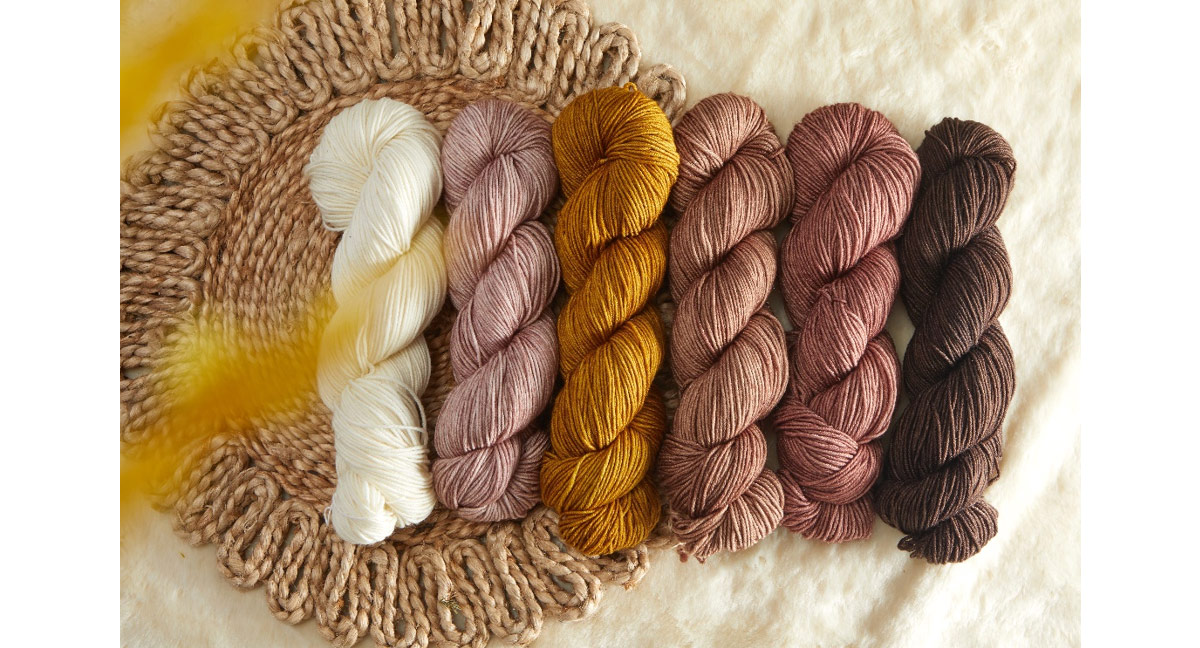Crochet vs Knitting: How Yarn Weight Choice Differ
- Blog Views : 1255
- Symfonie Yarns
- 01Aug, 2025

When it comes to fiber arts, crochet and knitting offer endless creative possibilities. You work with yarn and create sweaters, cardigans, socks, home décor and so much more with your crochet hook or knitting needles. Yet, a common question faced by both beginners and seasoned crafters is: How does yarn weight influence my project and does it differ between crochet and knitting? Understanding the difference is essential, as your choice impacts not only the look and feel of your creations but also their durability, flexibility, and overall success. In this comprehensive guide, we’ll break down the differences in yarn weight use between crochet and knitting, backed by a practical yarn weight guide and an easy-to-read table.
What Is Yarn Weight and Why it Matters for Knitting and Crochet
Yarn weight refers to the thickness of the yarn strand. From the lightest lace to super bulky types, yarn weight determines the gauge, drape, and warmth of your finished piece. Understanding the term is crucial for following patterns, achieving the desired texture, and ensuring your garment or accessory fits as intended. That's why most patterns and yarn labels will reference the ideal weight for any given project.
Now mostly knitting yarn and crochet yarn are the same. Manufactured or hand-dyed by skilled artisans they are available in a wide range of yarn fibers, weights and sizes.
Also read - The Ultimate Guide to Yarn Weights: Fingering, DK (Double Knit) vs Worsted
Knitting Yarn Weight Considerations
Knitting has a uniform looping technique, typically creates a softer, more elastic fabric. Yarn weight choices in knitting tend to closely match industry-standard recommendation.
Fingering Yarn: Ideal for delicate shawls, baby garments, and socks. Knitting utilizes these yarns to produce fine stitch definition and drape. Terra’s merino-polyamide yarn makes it the perfect sock yarn.
- DK Yarn: Perfect for sweaters, scarves, hats, and blankets, knitters love DK yarn weight for their balance of stitch clarity and fabric density. A favorite among knitters for versatility, extrafine merino wool is suitable for all projects while merino silk DK yarn is ideal for lacework, shawls and garments.
- Worsted Weight Yarn- A perfectly balanced yarn weight favored to be beginner friendly, the yarn weight suits quick projects that are soft and cozy.
- Heavy yarns (Bulky, Super Bulky): Used for quick-accessories, chunky sweaters, or home décor. These weights knit up fast and provide a warm, plush texture.
Knit fabrics, especially when worked in lighter yarns, often feel lighter and more flexible than their crocheted counterparts. When working from a pattern, knitters usually stick with the yarn weight specified for optimal results.
Also read - Knitting vs Crochet: The Complete Guide for Yarn Lovers
Crochet Yarn Weight Considerations
Crochet creates a series of interlocking loops that sit atop each other, resulting in a denser and more textured fabric. Crochet stitches are taller and thicker; they consume more yarn and produce a heavier fabric than knitting even with the same yarn weight.
- Fingering Yarn: Great for lacy shawls and delicate accessories or the handy granny square they are generally preferred for projects that require drape.
- DK Yarn: The yarn weight shines in crochet, providing solid drape while keeping the piece from becoming too bulky.
- Worsted Weight Yarn: These produce dramatically thick and structured items, think chunky blankets or statement scarves.
Crocheters often size down their yarn choice using a lighter weight than what is common in knitting to avoid stiffness and excessive bulk, especially for garments. This key distinction in the yarn weight guide is essential for crafters who use both techniques.
Also read – Knitting vs. Crochet: Which Yarn Craft is Right for You?

Why Does Yarn Weight Matter More in Crochet vs Knitting?
- Density Differences: Crochet fabric is inherently denser and less stretchy than knitted fabric. Selecting too thick a yarn for crochet often results in heavy, stiff items.
- Yardage Consumption: Crochet uses about 25–30% more yarn than knitting for the same project. Choosing a lighter weight yarn is often necessary to keep the project wearable and light.
- Pattern Translation: If adapting a knitting pattern for crochet or vice versa, consider selecting a different yarn weight to maintain the original project’s drape and feel.
Choosing the Right Yarn Weight: Tips for Each Craft
For Knitters:
- Follow the pattern’s suggested yarn weight and stick to the recommended needle size for best results.
- Experiment with fiber types for desired warmth and drape.
For Crocheters:
- Downsize yarn weight for garments to reduce stiffness.
- Use the yarn weight table to adjust your hook size and avoid overly dense fabric.
- When in doubt, create a swatch and test drape and flexibility.
Knitting vs Crochet with Same Yarn Weight
| Yarn Weight |
Project Example |
Knitting (Needle) |
Crochet (Hook) |
Effect Difference |
|
Fingering (Terra) |
Lightweight shawl/socks |
Drape, sleek finish; fine detail |
Dense fabric; detail lost unless hooks large |
Knitting gives softness; crochet is stiff and snug |
|
DK (Viva/Luna) |
Cardigan, cowl, scarf |
Flexible, structured fabric; good stitch pop |
Warm fabric; crochet patterns visible |
Both crafts work well, but quilting effect in crochet |
|
Worsted (Bella) |
Sweater, blanket, hat |
Quick stitch; cozy fabric; visible stitch |
Thick, sturdy; ideal for accessories |
Crochet is chunky & textural; knitting smoother and softer |
Mastering Yarn Weight for Both Crafts
Selecting the right yarn weight is foundational for success in both crochet and knitting. Remember that while patterns and labels offer guidance, your hands-on experience and swatching will always be the ultimate test. Explore your creativity in every project—knit or crocheted. With Symfonie Yarn collection get hand-dyed yarn skeins that are beyond beautiful. Extrafine merino wool, merino-silk and merino-polyamide yarn blends in fingering, DK and worsted weight options. Each skein is OEKO Tex 100 certified making it suitable for use against skin.
For better understanding of the topic on knitting vs crochet yarn crafts, also read:
Knitting or Crochet: Which Crafting Style Uses More Yarn
Yarn Weight Calculator: How Much Yarn Do You Need for Knitting & Crochet Projects?
Guide to Choose the Best Yarn Weights for Different Knitting Techniques
-
- 08 Dec,2025
-
- 02 Dec,2025
-
- 27 Nov,2025
-
- 24 Nov,2025
-
- 19 Nov,2025
-
- 17 Nov,2025
Copyright © Symfonie Yarns 2025 - all rights reserved | RSS Feed
